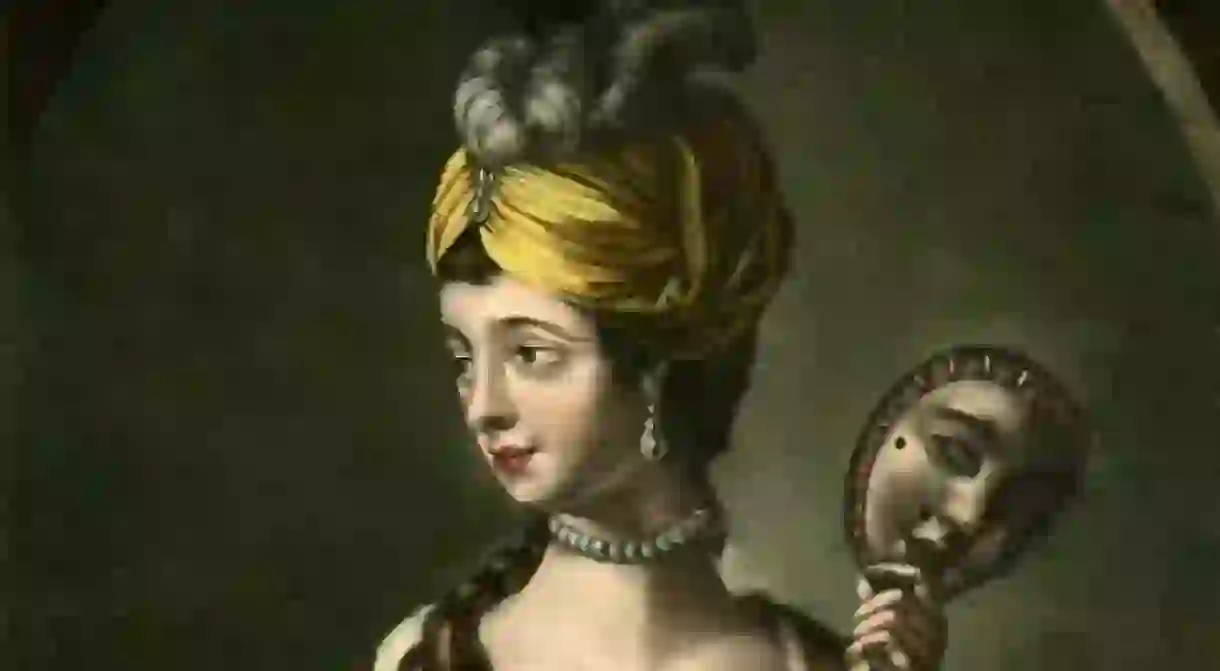Fall in Love With This Excerpt From 'The Face: Our Human Story'

The British Museum has collaborated with publishers Thames & Hudson on two new books that promise unprecedented insights into the museum’s exhibitions. Bestiary: Animals in Art From the Ice Age to Our Age and The Face: Our Human Story are also illustrated with gorgeous images from the British Museum’s collection, making them a welcome addition to any coffee table. This excerpt from The Face by Debra N Mancoff examines how love and desire play out in facial expressions.
What does a lover see in the face of their beloved? Across culture and over the centuries, writers have turned to allusion and analogy in order to convey the complex passions stirred by a glimpse of their loved one. The twelfth-century Persian poet Nizami tells us that Prince Khusraw adored the beautiful Shirin, whose face was “like a wild rose” and whose lips were “sweet as her name”. In the Song of Solomon, the bridegroom celebrates the arrival of his bride by comparing her eyes to doves, her cheeks to pomegranates and her lips to a scarlet thread. Dante Gabriel Rossetti, founder of the Pre-Raphaelite Brotherhood, likened the beauty of his beloved to “genius”, that eternal and inexplicable spark of creativity that drives the artist’s hand and fuels the poet’s imagination. But it was Leonardo da Vinci who claimed that, when it came to evoking an impression of the face of desire, the power of the painter transcended the poet, for only the painter could craft a likeness so true that the lover would be compelled to speak as if in the presence of their beloved.

Although love’s ancient agent Cupid is often represented as blind, ideas of beauty are entangled with those of love. Fine features and a comely mien can kindle infatuation; but just as there are many aspects of love, there are any standards of beauty. Difference plays out in proportion and detail: the shape of the eyes or lips, the depth of the forehead, the contour of the cheek, the shade of the skin. But despite cultural distinction and preference, certain qualities – symmetrical features, a clear complexion and large, bright eyes – seem to possess universal appeal. They are also the hallmarks of youth and health, making beauty fleeting and therefore more precious. Time takes its toll on beauty: firm skin sags, bright eyes dim and life’s experience leaves its mark on every face. But love can outlast beauty, for it engages the mind and heart as well as the eye. Indeed, a beloved face has a beauty all of its own, rooted in an endearing individuality, a shared history and the compassion and respect between those who love.

No single facial expression can encapsulate the range of emotions that stir the heart. Fond glances and flirtatious smiles may signal the start of a seduction, affirm an established bond or mark a passing fancy. Lovers may show their restraint in calm, composed dignity, or they may indulge their desires in a heartfelt kiss. Sexual passion is more than a matter of bodily union; the faces of lovers reflect their individual ardour, whether in surrender, ecstasy or pure delight. But attraction is not always mutual, and love is not always reciprocated. A lonely lover yearning for another turns inward, lost in bittersweet thoughts that are burnished by memory or desire. False love is calculating, and the deceitful lover seduces through feigned smiles and sly glances, luring victims into temptation’s trap. A kiss that enflames one may disgust another, and love that fails devolves into anger and hate, turning fond glances to furious glowers and gentle smiles into sullen scowls. A disappointed lover cannot hide heartbreak. Lost love – whether through betrayal, rejection or even death – brands the face with sorrow. The eyes, once focused and bright, turn distant and dark; the cheek pales and hollows; and the mouth no longer mobile and yielding, settles into a hard line of regret or resignation. The power of love wields pain as well as pleasure, and each romantic story leaves telling traces on a lover’s face.
The Face and Bestiary will be published by Thames and Hudson on 20 September 2018, each at £16.95.













